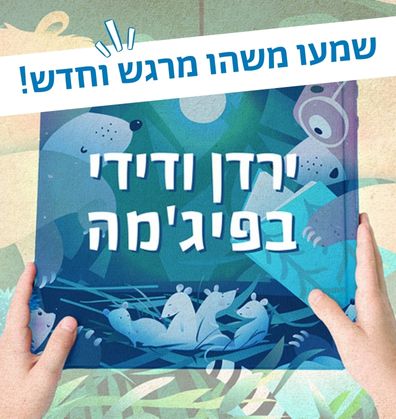אֲנִי וְעַצְמִי
גדילה
בתהליך הגדילה אשר מתפרס על פני שנות התפתחות והתבגרות רבות, ילדים וילדות מרגישים לפעמים גדולים ולפעמים קטנים. הם מתנסים, לומדים, לפעמים נופלים וגם קמים. ספרים אשר במרכזם מתוארים גיבורים שעוברים תהליך גדילה והתנסות, מעוררים הזדהות והשראה לשיח משמעותי על רגשות, ולחיזוק הדימוי העצמי.
סְּפָרִים
Book-Related Family Activities

Tip for Family Reading
Children enjoy feeling all grown up. While reading a book, let your children play a part, and enhance their sense of capability: You can ask them to select a book off the shelf, hold it, turn the pages, or even tell you or one of the stories in their own words.

I Can’t
Avivi tells her mother that she cannot tidy up her room because she is too small. After reading this book, you can discuss and think together – is it easy or hard to tidy up your room? What can help you tidy it up? What are you able to do now that you were not able to do in the past because you were “too small” to do it?

Tidying up before the time is up!
You can have fun and try to break a “family record” in tidying up a room: Place various toys and items in the main room of the house, set a timer, or decide when the time will be up. Ready? Set? Go and work as a team to put all the items back where they belong as fast as you can! How long did it take? Did you finish before the time was up?
Puppet Theater
Avivi asks her toys to tidy up the room, but they say they can’t – the teddy bear is too tired, and the frog is too lost… How about your toys? What are they unable to do and why? What would you like to ask them to do? You can put on a show with puppets and toys, making up various day-to-day situations or tasks for them to do together.

Family reading advice
A song that has been turned into an illustrated book gives readers the opportunity to experience it differently, understand it anew, or refamiliarize themselves with it. Therefore, when reading such books for the first time, try not to be tempted to “sing the book”, but instead to read it as you would any other story.
The wonderful children’s author and poet Ayin Hillel (1926–1990) was born and raised in Kibbutz Mishmar HaEmek. Although he was a landscape architect by profession, more than anything else he enjoyed writing poems for all ages. David Polonsky is among the most prolific Israeli illustrators. Internationally renowned, he has illustrated well-known children’s books, created film animation, held numerous exhibitions, and is the recipient of many awards.

Time goes by
Questions stimulate discussion and thinking. You can look at the illustrations in this book and ask: What is the boy doing on each page? What does he look like in the beginning of the book? And what does he look like at the end? You can be inspired by the illustrations to look at old pictures of yourself, seeing how you have grown, and ask questions – What was I doing when I was one year old? And what am I doing now? What have I discovered and learned since then?

What do they do?
What does a washing machine do? And what does the ceiling do? Following this book, you can walk around your home or outdoors, and ask questions about the things you see around you: “What do they do?”
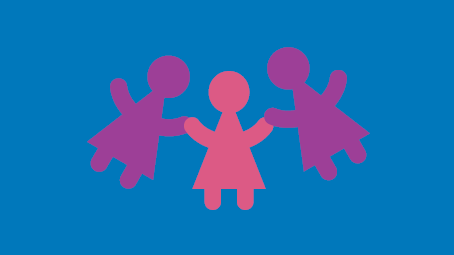
Discovering the world
This book asks many questions and gives a range of amusing answers to them. It invites you and your child too to explore and discover together; you can ask your child – What else do trees do? What else do clouds do? You can even make your own book of questions & answers. Write them down and add some illustrations. Any time a new question comes up, you can add it to your book, and look for the answer.

QR Code
The music for Ayin Hillel’s well-known and well-loved song was composed by Naomi Shemer, and has since become an Israeli classic. Scan the QR code to listen to it.
Family Reading Advice
The encounter with different illustration styles develops toddlers’ sensitivity to color and aesthetics, as well as their attention to detail. The illustrations in this book have been placed into boxes, much like a comic book. While reading, you can help your toddlers follow the plot by pointing at the right box, and asking questions about the details that appear in it.
Sharing House Chores
You can discuss with your toddlers and ask: Do they help around the house? How? What other chores would they like to take part in? How do they feel when they do things around the house themselves? Are some things too hard? You can talk about your own experiences – the kinds of things you learned to do when you were their age.
Listen to the Story
Listen to Didi and Yarden read this book on the Sifriyat Pijama podcast.

Fun Tasks
You should think of a house chore that your toddlers can take part in and turn it into an experiential game. For example: Taking all the socks that have just been washed and dried, pulling one over your hand, and having it help you look for its mate; or turning vegetable-rinsing into a vegetable “shower” under the faucet, or a “bath” in a bowl.

Egg-Ball
Suggest that your toddlers experiment the various ways that Yehoshua attempted to bring the egg by using a ball – throwing and catching it, placing it on your head, holding it and running… You can also try different-sized balls, or soft or hard ones, while noticing what each one feels like.
Family reading advice
Reading independently:
While reading, toddlers can participate and feel all grown-up and independent. They can choose the book, hold it and turn the pages, point and say words they know. Encouraging toddlers to participate in reading will bolster their sense of capability, and enhance their connection to the world of reading.

Doing things on my own:
You can discuss the things that toddlers learn to do by themselves, and ask: What do you do at home all by yourself? What do you need help doing? Are there things you would like to learn to do on your own? How can we practice something new that you would like to learn how to do?
Characters for Print
Print out the characters from this book, cut them out, stick them onto popsicle sticks, and act the story out yourselves, or make up what happened on the eighth day in the book using these characters.
Download Here! 🐞⚫🔴

Illustrations
The illustrations contained in this book are full of details. You can look for a new detail every time you read it, just like Tim Tam finds a new dot each day. Where is Tim Tam? Where are the black dots? What other shapes can you notice? Which animals appear on each page? Which items can be found at Tim Tam’s house?

Looking for dots
Tim Tam learns to notice the dots around he and find them. You can look for dots and round objects together in your surroundings. Where are the dots hiding? Perhaps on your shirt? Your body? Which round items do we have at home? You may even encounter one of Tim Tam’s ladybug friends.

A ladybug finger:
Use two fingers to lightly tap your child’s arm, leg, or face, and travel along it like a ladybug. Where does it feel nice? Where does it tickle? Where can you feel it more, and where can you feel it less?
Family reading advice – Finding your own way
Who says that stories must be read at bedtime? Maybe you prefer reading them in the afternoon? Or lying together on the rug, or having a stuffed toy join you while reading? Every toddler has his or her own personality and needs, and grownups, of course, have their own preferences too. You can look for the best reading time and method for you and your toddler, and create your own special story hour.
Reading with movement
While you read, you can shoo the fly away together with your toddler, just like the child in this story: You can clap, jump with your entire body, or move only your hand, or sneeze ever so loudly, and then look right and left for the fly that flew away.
QR code
Would you like to sing with the fly that got lost? Scan the code and listen to the song the “Fly That Got Lost”. You can dance, fly, and make buzzing sounds together.

The buzzing finger
Your finger can become a fly too: Make buzzing sounds and wiggle your finger in the air as if it were a fly. You can see your toddler following the “flying” finger. You can place your finger on another area of your toddler’s body each time: his or her nose, cheek, arm or ear. You can say: “Buzz on the forehead” out loud, while going over the names of their body parts and laughing together. Once your toddler has become familiar with this game, you could invite him or her to make a finger a fly too.
Real or imaginary?
Telling and listening to stories is great fun. The shared experience makes everyone feel good. Discuss and think together – when is the right time for story-telling and letting your imagination run wild. When is it best to tell the story like it is — without adding or leaving out any details? Who would you feel comfortable confiding in when you face dilemmas?
What happened to me yesterday
Who can remember what happened yesterday? Can you tell it like a story? You can use this opportunity to share experiences. You can also play: One of the participants will tell a story, while the others try to figure out what is true and which parts are made up.

Here is where we listen
Whenever Shahar wants to share or consult, she sits on the bench with Herzl, the security guard, and he always listens. Choose a spot at home where you can always speak and be heard. Whenever you need to share, sit there, tell your story, and seek advice.
Let me tell you a story
Do you want to listen to Shahar’s stories too? Scan the QR code and listen away.
Family reading advice
Reading books is a wonderful way to get to know a child’s world. When reading, you may want to pause every once in a while, and allow your child to respond to the events depicted in the book: How do the characters feel? How do we, as readers, feel? Has something similar ever happened to you?

Discussion – large and small
Have you ever helped to make a salad? Have you ever fallen and hurt yourself? You may enjoy recollecting together, parents and children, moments when you felt big, and managed to do something all on your own, and other incidents when all you wanted was to be hugged and comforted. This may be a good opportunity to get to know your child’s experiences, while sharing special moments with them from your own childhood.
Is it better to be big or small?
What is better? Scan the QR code to sing along with your child and think what is better – being big or small?
Looking at the illustrations
While reading, you may enjoy looking at the illustrations and searching for interesting details: What is Matan doing? How many animals can you spot? Who is large and who is small? Where can you see a cat? And which of the illustrations is your personal favorite?

Big or small?
Pick up two objects and compare them – which of them is small and which is big? Now, replace one of the objects with another, and check again: Is the teaspoon big or small when compared to a bottle cap? And what happens when it is next to a broom? You can use yourselves as one of the objects and check whether you are big or small. And what happens when you stand next to other family members?
Reading with Toddlers
How do we turn books into friends? Reading from a young age contributes greatly to toddlers’ development. We suggest starting slowly, gradually, and age-appropriately: Some toddlers will want to touch the book, open and close it, or even “taste” it. You can then read a little, patiently and enjoyably. You can start by reading one page, and, as you get used to it, add more pages, until, hey – books have become friends!
Reading together – Good Morning
While reading, you can emphasize the words good morning using a special voice and welcoming gesture. Invite toddlers to join in, follow the story, and take an active part in the reading. You can create your own good morning greetings: “Good morning kitchen chair!” “Good morning tree on our street!”, “Good morning, Bobby the dog!”

Observing the world
For toddlers, everything can be a teachable moment. Time spent together going to or from daycare provides an opportunity to observe what attracts toddlers’ attention: Is it ants walking in a row? A large truck? Or perhaps a flock of birds?
Reading together, experiencing together
This book allows toddlers to take an active part in its reading, for each page ends with an intriguing question, to be answered on the following page. You may enjoy allowing your toddler to turn the pages and find the answer.
Going outside
The Pear is Extra Sweet invites readers to go outside and discover the wonders of the world close to their homes: you could rest under a tree in your neighborhood, have a snack there, and play with fallen leaves. Perhaps you would enjoy taking this opportunity to introduce your toddler to magnifying glasses: look through the magnifying lens, and see what the world looks like close up.
What happens at nightfall?
Various items found in our immediate surroundings are shown on the final page of the book. You may want to examine what the back yard holds with your toddler, and where in the book each item is found. You could even use the final page to recall your day together, and sum it up with your toddler: where were you today? Who did you meet, and what did you do?
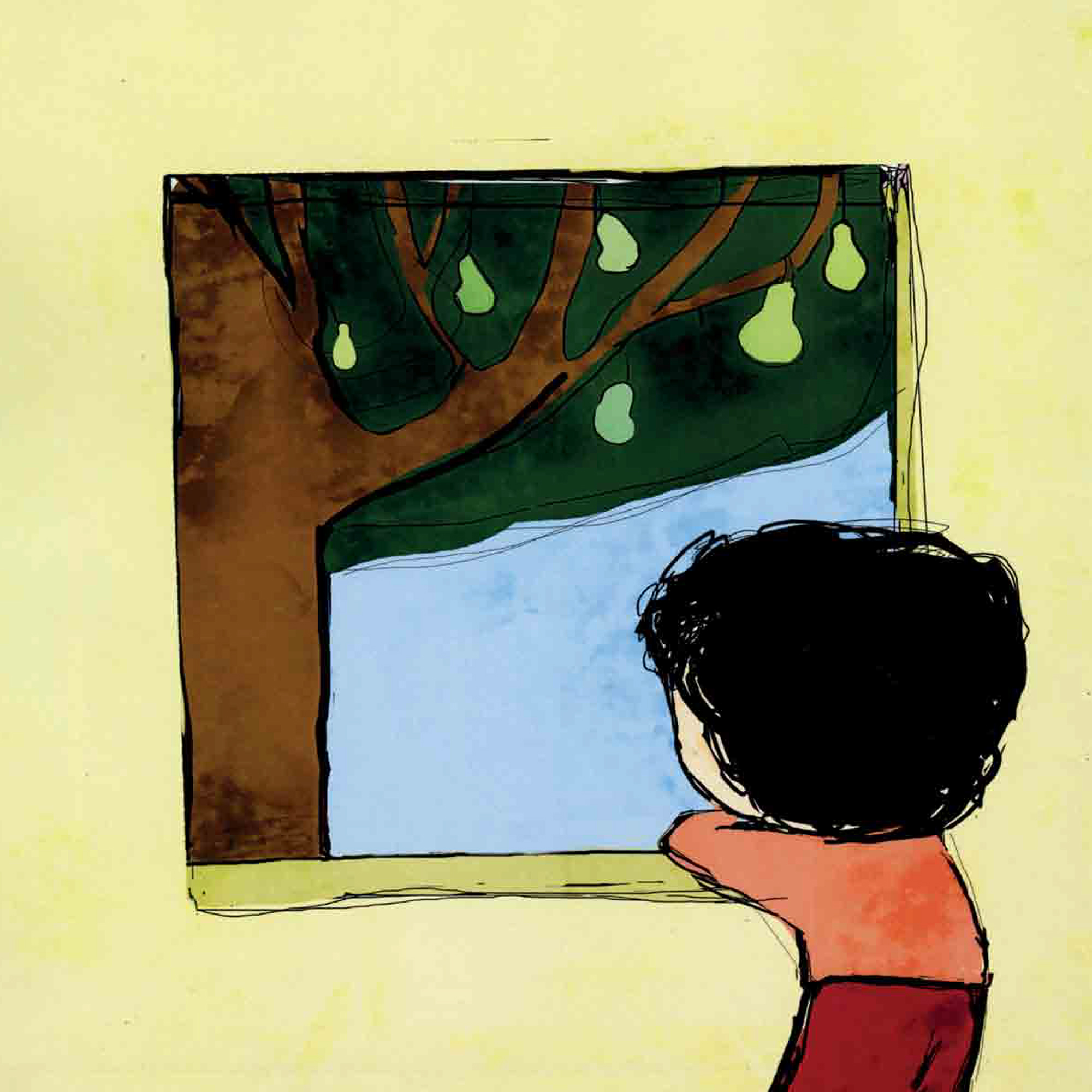
The puddle-boat game
Even if it isn’t raining, you could create a small puddle in the back yard or in a large bowl, sail paper boats on it, feel how wet the water is, and add fallen leaves and branches into it. Wondering how to make a paper boat? Log onto the book’s webpage or the PJLibrary Pinterest page for easy paper boat making suggestions.
What do you see out of your window?
You may enjoy looking out of your window together to see what moves and what remains static. Can you hear any sounds? Have you discovered anything surprising? Perhaps you would like to look out of your window during the day, and again in the evening, after nightfall. Did you discover different things by day and by night?
Proposed Family Activities:
- You may want to leaf through the book together. Did you find anything about the illustrations amusing? You may want to ask your child to use them in order to identify the different characters’ activities.
- At the end of the book, the entire family sits down for a Shabbat meal together. Can your child identify each character as it sits round the table? You may want to ask them to point at some of them, and try to remember the two activities each of them likes to do.
- You may enjoy holding a Shabbat meal for some toys using plastic dishes. You could ask your child who to invite, what the toys should have, what they can do while dining together, and what is best not to do while sitting around the table.
- You may want to try doing different things at the same time, like singing and playing ball, showering while listening to a story, or putting toys away while clapping. Were you able to do both?
- You could discuss your family with your child. Ask them when you usually get together for a meal, and what you usually do on Shabbat.
Sitting close and reading together
Sitting close and reading together – You may want to look for the illustration of the wilted tree, stop reading, and ask your child for their opinion as to why the tree is not blooming, and what it is missing. At the end of the story, you may want to discuss what caused the tree to bloom once again, and whether that was Mr. Zuta’s intention when he planted the flower patches.
Do trees have feelings?
Do trees have feelings? Perhaps you would enjoy looking for the page on which Mr. Zuta’s friends suggest that he get rid of the tree. You could imagine a dialogue taking place. If the tree could speak, what would it say to Mr. Zuta and his friends?
I want a garden too!
I want a garden too! – Mr. Zuta is jealous of his friends’ gardens. You may want to share a memory with your child of having wanted something that another person had. How did you feel? What did you do? If you would like to have a garden too, you could plant flowers, herbs, or vegetables in your yard or window-box. Look after your plants, and watch them grow.
Planting a community garden together
Planting a community garden together – You may want to take a walk in the area surrounding your home. Are there any open spaces, or abandoned courtyards? You could clean up the area together with some friends, and make it more beautiful. You could even plant a community garden in collaboration with your neighbors.
Right under one's nose
Right under one’s nose – Mr. Zuta did not notice the change in his apple tree until his friends remarked on it. Have you ever failed to notice something good that was happening around you? You may enjoy walking through your house and backyard, looking for all the beautiful things that have grown or changed there lately.
A recipe for apple crumble
Ingredients
For the crumbs:
100g of sugar
80g of butter, cubed
100g of flour
For the apples:
5–6 apples
20g of butter
3 tablespoons of sugar (you could add a tablespoon of cinnamon or lemon juice, depending on your preference).
Method:
- Mix the sugar, butter, and flour together until you get medium-sized crumbs. Store in fridge for one hour.
- Peel the apples, and cut them into wedges.
- Melt the butter in a frying pan, and cook the apples in it for 10–15 minutes while stirring, until the apples are soft, but retain their shape.
- Place the apples in a baking pan, sprinkle the crumbs on top, and bake in medium–high heat for approximately 20 minutes, until golden.
- Serve hot or at room temperature. Bon Appetit!
האם הילדים מכירים קומיקס?
האם הילדים מכירים קומיקס? סיפור קומיקס, או “עלילון”, הוא בעצם סיפור כפול: הרפתקאותיו של אורי כדורי כפי שמתוארות במילים, ועלילת הציורים. לא צריך לדעת לקרוא כדי לפענח טורי קומיקס! ילדי הגן יוכלו “לקרוא” את הציורים ולספר את הסיפור במילים שלהם.
להסב את תשומת לב הילדים לכלב הגדול שלמלווה את אורי ברוב הרפתקאותיו
כדאי להסב את תשומת לב הילדים לכלב הגדול שלמלווה את אורי ברוב הרפתקאותיו. הכלב לא מוזכר בסיפורים, והוא פרי דמיונה של המאיירת רותו מודן. אפשר לשוחח עם הילדים, מה עושה הכלב בסיפורים?
לצייר טור קומיקס
ילדי הגן יכולים גם לצייר טור קומיקס. ניתן לבקש מהם לבחור סיפור מוכּר ולהכין ממנו קומיקס.
משחק: כל אחד בוחר חפץ בחדר ועושה בו שימוש מצחיק ובלתי-שגרתי
אחד הדברים המצחיקים ב”אורי כדורי” הוא השימוש הבלתי-שגרתי בחפצים מוכּרים. אפשר לשחק משחק: כל אחד בוחר חפץ בחדר ועושה בו שימוש מצחיק ובלתי-שגרתי. על השני לנחש לְמה הפך החפץ המוכּר.
לשאול את הילדים מה הם ממציאים ולבקש שיתבוננו בתמונות ויגלו מה החליט אורי לעשות.
אורי כדורי ממציא פתרונות מגוחכים לבעיות שונות (כיצד להתייבש לאחר הגשם, מה לעשות בקליפת בננה כשאין בסביבה פח, איך להתאים את גובהו של כסא לשולחן…). אפשר לקרוא את סיפורונים יחד ולעצור לפני הפתרון, לשאול את הילדים מה הם ממציאים ולבקש שיתבוננו בתמונות ויגלו מה החליט אורי לעשות.
לשוחח בקבוצות קטנות
האם עלילותיו של אורי כדורי הצחיקו את הילדים? איזה סיפור אהבו במיוחד? אפשר לשוחח בקבוצות קטנות, לבחון את הפרטים הקטנים שבאיורים ולאפשר לילדים להביע את העדפותיהם.
מפגש בדיחות וצחוק
בעקבות הקומיקס ולקראת חג פורים אפשר לערוך יחד עם ההורים “מפגש בדיחות וצחוק”, עם סדנאות לכתיבת קומיקס, שעשועים וחידות, ושירים היתוליים.
יצירות נוספות שכתבה לאה גולדברג
האם ילדי הגן מכירים יצירות נוספות שכתבה לאה גולדברג (למשל, “איה פלוטו?”, “דירה להשכיר”, “הילד הרע” ועוד)? אפשר להכיר לילדים את דמות היוצרת ולערוך תצוגה בגן. כדאי לבקש מהילדים לחפש בבית ספרים ושירים פרי עטה ולצרף אותם לתצוגה.
לספר את העלילה במילים
לא צריך לדעת לקרוא כדי לפענח טורי קומיקס! ילדיכם יוכלו “לקרוא” את הציורים ולספר את העלילה במילים שלהם.
להכין קומיקס
גם ילדים צעירים יכולים לצייר טור קומיקס. ניתן לבקש מילדיכם לבחור סיפור מוכּר ולהכין ממנו קומיקס.
לשחק משחק: כל אחד בוחר חפץ בחדר ועושה בו שימוש מצחיק ובלתי-שגרתי
אחד הדברים המצחיקים ב”אורי כדורי” הוא השימוש הבלתי-שגרתי בחפצים מוכּרים – למשל, כאשר אורי כדורי תולה את עצמו על חבל הכביסה, או מושיט חכה כדי לדוג דג זהב מתוך אקווריום. אפשר לשחק משחק: כל אחד בוחר חפץ בחדר ועושה בו שימוש מצחיק ובלתי-שגרתי. על השני לנחש לְמה הפך החפץ המוכּר.
לקרוא שוב את הקומיקס ולשאול את ילדיכם, מה הבעיה ומה הפתרון בכל סיפור?
כל אחת מעלילותיו של אורי כדורי עוסקת בפתרון מגוחך לבעיה שעומדת בפני הגיבור. אפשר לקרוא שוב את הקומיקס ולשאול את ילדיכם, מה הבעיה ומה הפתרון בכל סיפור? יחד תוכלו להמציא עוד פתרונות מצחיקים לבעיות.
מה מצחיק אתכם?
מה מצחיק אתכם? בעקבות הקומיקס ולקראת חג פורים אפשר לערוך “ערב בדיחות וצחוק” במשפחה.
יצירות נוספות שכתבה לאה גולדברג
האם אתם מכירים יצירות נוספות שכתבה לאה גולדברג? אפשר לחפש בבית, בספריית הגן או בספרייה המקומית ספרים ושירים פרי עטה וליהנות יחד גם מהם.
Family Activities:
- Do the members of your family enjoy it when it rains? After reading the story, you might have a conversation with your children and ask them whether they, like Tzafrir, love rain. Why? Who needs rain, and who enjoys it? Ask your children whether they know any other stories, songs, and tales about the rain. You can all snuggle together in a cozy corner of your home and tell stories about the rain.
- Tzafrir asks: “Mommy! Will the rain ever come?” Like many children, Tzafrir is full of anticipation and has a hard time waiting for the rainy season to begin. Suggest to your children that they look for changes in the weather that indicate winter’s coming (for example: birds migrating south, days getting shorter, skies becoming cloudy). You could also have a conversation about things in life that we can control, versus things over which we have no control.
- “Tzafrir was still a little boy last winter”: You might talk about things your children are able to do now that they couldn’t do last winter. You could also take out their shoes, clothes, and boots from last winter and see if they still fit, so your children can see how much they’ve grown and developed since then.
- Your children can join in anticipating and tracking the rain (or snow, if you live in a cold climate). Work together on designing a tracking chart. Every evening during the winter months, they can make a mark (or draw a picture) to indicate whether rain (or snow) fell that day. When the season is over, you can all count together the number of days on which there was some precipitation.
- You can also make a rain collector: take a plastic bottle and cut off the top (be careful not to cut yourselves on any sharp edges!). Place the empty bottle in an open area outdoors, or attach a loop of metal wire and hang it outside your window. How long does the bottle take to fill up? Your children can track the rise of the water level in the bottle, and then decide how they want to use the water they’ve collected.
- You and your children can also go on a puddle expedition, just like Tzafrir and his family. Don’t forget to wear boots and bring an umbrella!
- You can set aside special games and other entertainment, to be opened on rainy days! Ask your children to decorate an empty shoe box. You can then fill the box with small surprises, like stickers, paints, beads, or a bottle of soap bubbles, along with little handdrawn notes containing ideas for fun family activities for a rainy day (play word games; read books; cook and bake; etc.). Hide the box, and bring it out only when it rains!
Leah Goldberg
Leah Goldberg (1911-1970), born in Kovno, Lithuania, was a poet, author, and translator. She studied at the universities of Berlin and Bonn, and received a PhD in Semitic Linguistics at the age of 22. Two years later (in 1935), she made aliyah to Israel and established herself as a renowned poet. She edited and wrote children books, including Where Is Pluto?, Apartment for Rent, and many others which have become classics of Israeli literature. Goldberg also headed the Comparative Literature Department at the Hebrew University of Jerusalem. In 1970, she was awarded the Israel Prize for literature, but unfortunately passed away two months before the prize ceremony. Her mother accepted the prize in her name.
Family Activity:
- Gad feels that there is a “naughty boy” inside of him that is making trouble and irritating him. Discuss together: Is there really a “naughty boy” inside of him?
Who swears at the auntie and pushes Yocheved: Gad, the “naughty boy”, or both of them together? Where is the “naughty boy” when Gad is not angry? What do you think?
- The illustrator Danny Kerman chose to represent the “naughty boy” by drawing a small shadow of Look at them both (Gad and the “naughty boy”). What is the “naughty boy” doing when someone is angry with Gad? Choose one of the illustrations and make up a “shadow conversation” between two characters, using your hands: Shine a bright light on the wall, using a lamp or flashlight. One of you will make shadows with your hands as if you were the “naughty boy”, and the other will respond as if they were Gad.
- The adults are upset with Gad: Father says he is acting like a baby, Yocheved’s mother calls him a “savage”, and Grandmother is so angry her nose turns green. What do you think about the behavior of the adults who talk to Gad?
- Discuss with your child an incident when you could not overcome your anger. What can one do in order to prevent this? If we are angry, how can we deal with the consequences of this feeling?
- Gad says: “I have tried everything… in order to make the ‘naughty boy’ go ” There are seven illustrations in the book that describe Gad’s attempts to deal with the “naughty boy”. Look at these illustrations and try to identify how he is dealing with the “naughty boy”.
- Gad asks: “What shall I do with him, with the ‘naughty boy’?” Like Gad, we all have urges and habits that we are not proud Choose a habit that you would like to overcome and in this way become a hero or heroine! Make a “Badge of Bravery” to award the heroes (e.g.: a medal, crown, sticker, etc.) and award it to the children when they overcome their urges and behave maturely.
- The “naughty boy” is often troublesome, but he also has some good characteristics: courage, independence and a strong will. Surprisingly, he even knows how to dance! Inside the book cover there are a series of illustrations of the “naughty boy”. When one looks at them in sequence, it seems as though the “naughty boy” turns his anger into dancing. You’re welcome to dance with him. Choose a few moves for the children to do and create a little dance. You can sing or drum to accompany the dancing.
Family Activities:
- You can flip through the book together with your children, looking at OraAyal’s heartwarming illustrations and pointing out each of the occasions on which the blanket helped Maya. You might ask your children what they think made the blanket change its size as the story went along.
- Like Maya, many children have a “lovey” (rag, blanket, pacifier, stuffed animal, or doll) that they take with them everywhere. Talk with your children about the strong attachment Maya feels for her “Blankie,” and share your own experiences: When you were young, did you have a favorite object to which you were particularly attached? Do your children have one? Perhaps you, too, want to embark on a “journey” with the item and do some growing with its support.
- Maya really wants to be four years old already. You could ask your children if there are things “big kids” do that “little kids” don’t. Together you could make an illustrated listof your children’s achievements and capabilities: things they know how to do today andcouldn’t do a year ago, and what they would like to be able to do when they are older.
- You might discuss special occasions throughout the year: holidays, the first or last day of school, important events in the life of your family. How do you mark all these occasions? Do you recite the Shehehiyanublessing, and if so – when?
- How does your family celebrate birthdays? Maya’s story underlines the point that maturity is measured not only by how old you are, but also by your actions. After reading the story, you might add a new custom to your family birthday celebrations—one that will give your children a chance to display their new-found maturity. You could suggest that they choose a toy, an item of clothing, or a doll or stuffed animal that they no longer need “because they’re big,” and give it away to a younger child.
- You could also hold a birthday party for one of your children’s dolls or stuffed animals – plan the party, make decorations, sing songs… everything you do for a birthday!
- Young children’s perception of time is not yet fully developed, and many children, like Maya, ask, “When will…?” Working together, you could design a weekly calendar showing all the days of the week, and then mark each passing day with a small picture or sticker.
Family Activities:
- Together with your children, take the time to look closely at Na’ama Benziman’s beautiful illustrations. You may want to stop at the page where Emilia approaches the three steps leading to the preschool, and note the changes in her facial expression.
- After reading the story, you can make up your own fantastic story and draw it.
- Emilia really wanted to enter the classroom on her own, “without any problems and without making a scene”. You and your child can look at the first illustration in the book, that depicts Emilia saying good-bye to her mother, and compare the entrance to her classroom with your child’s schoolyard. What helps your child say good-bye and go into the classroom in the morning? Do you have a special ceremony or technique that eases the separation? After reading the story about Emilia, you may want to invent a new way to say good-bye in the morning, a way that will help your child feel grown-up and brave.
- Like Emilia, each one of us feels sometimes big and other times small. You can read the story together again and take note of the points in the plot when Emilia feels big and when she feels small. You might ask your child when they feel big and small, and emphasize the advantages of each condition.
- Emilia’s friend Dana enters the story at precisely the moment when Emilia is feeling lonely. You can use this as an opportunity to talk about friendship. You might ask: What do we like to do together with our friends, when do we prefer to be alone and what is more enjoyable to do together with others?
- Dana is very happy to see Emilia, and they play together. You too can play together and even make your own tea party like the girls in the story. What will you serve at your tea party, who will be big and who will be small? You can invite other family members, dolls or stuffed animals to join your party.
- You can recount all the things your child knows how to do alone, and some tasks he or she needs help with. You might want to share an experience of your own, and tell your children about a time when you overcame an obstacle on your own – and when you were helped out by family or friends.
- Emilia’s journey into the classroom is depicted like a dream. You might want to talk to your child about dreams. Do you remember your dreams? You can try to draw a picture of one of the dreams you or your child dreamt.
- You may want to take this opportunity to share one of your own childhood experiences with your child. Did you attend preschool? If so, do you remember being sad saying good-bye in the morning? With whom did you play, and what did you like to do with your friends? You might want to compare your preschool with your child’s current classroom.
רעיונות שהציעה נעמה בנזימן לפעילויות עם הילדים סביב האיורים שבספר
לחצ/י כאן לרעיונות שהציעה נעמה בנזימן לפעילויות עם הילדים סביב האיורים שבספר
Family Activities
- You may want to look through the book for Little Gorilla and discover where he is hiding in each illustration. Try to imagine what his fur feels like, what he eats, and how big he is. Do you also like Little Gorilla?
- You may enjoy reading the story once more, and replacing the words Little Gorilla with your child’s name. Instead of jungle animals, say the names of your friends and relatives, who all loved your child when s/he was born, and love them still.
- Perhaps you would like to look at family photographs together, and remember what your child looked like when s/he was born. You could tell your child how happy and excited the whole family was when they were born, and share stories of the help extended by friends and relatives, as well as the joy surrounding the new addition to the family.
- It’s great to be big! You may enjoy recalling all the things your child can do today that they could not do when they were “little”, such as walking, talking, reading together, feeding themselves, putting their toys away, etc. When your child helps to clear the table or tidy up the room after playtime, you may want to commend them and say: “It’s great that you’re so big!”.
- Little Gorilla celebrated his birthday in the jungle. You may want to imagine what the animals’ party was like and discuss your thoughts. Did they make him a special cake? Or sing songs? Perhaps you could act out Little Gorilla’s birthday party using stuffed animals.
- It’s nice to liken our love for our children to a plant that always grows. Before bedtime, you could kiss your child and tell them you can’t wait for tomorrow to come, so that they’re a little bigger, and your love for them will grow some more too.
You may want to read the story several times
You may want to read the story several times, enjoying together the rhyming games and opposites, and accompanying Miriam on her quest for the sea. After several readings, your child will probably be able to complete the sentences, and “read” the story themselves.
Does your child know the sea?
If you do not have a beach close by, you could spend some time at the pool, fill a tub in the back yard, or even have a bath. Take simple seaside playthings along with you, such as a funnel, sieve, and various sized plastic bottles. Have fun!
Miriam's questions contain many opposites
hot–cold, big–small, old–new etc. You may enjoy playing an opposites game together. One of you could ask the other: “Is it ______ (hot, big, old…)?” and the other could reply: “No, it’s ________ (cold, small, new..)!”
You may enjoy playing the "warm-cold" game together
One of you thinks of an object in the room, and leads the other toward it using clues of “warmer” (the object is close by) or “colder’ (the object is far away).
Following the story, you may like to have a conversation with your child about seasons,
Following the story, you may like to have a conversation with your child about seasons, and discuss how our activities change in winter when it is raining outside, and in summer, when it’s hot out.
Mirik Snir wrote dozens of wonderful books for young children
Mirik Snir wrote dozens of wonderful books for young children. You may want to look for them, at home or the library, and read them together
Find the animals
Yossi Abulafia has put some entertaining details in the illustrations that aren’t mentioned in the story. Try to find the dog and the cat on each page. Did you find them? What are they doing? What sort of expression do they have on their faces? You could try imitating the facial expressions and movements of both the dog and the cat. What else did you find in the illustrations? Do your children know the names of the different objects?
Dad and Noam, you and your children
Nira Harel tells us which games Noam likes: playing ball, hugging his teddy bear, and playing ‘pretend’ games. You and your children can play ‘pretend’ together. Each one takes a turn pretending to be Noam—saying “That one!” while pointing to something in the room. The family member pretending to be Noam’s Dad then tries to guess which object is meant. At the end of the game everybody hugs and laughs, just like in the story.
There is nothing like a sense of humor to defuse tension in moments of frustration
There is nothing like a sense of humor to defuse tension in moments of frustration. Next time you are struggling to understand what your children are saying, try remembering “That One!” Recall the father’s sense of humor and the funny illustrations. Then maybe when your children ask for “that one,” a loving hug will help you, too?

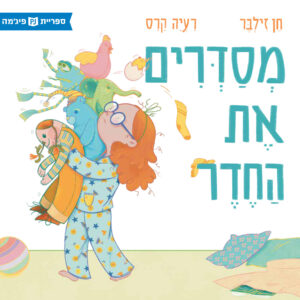 Tidying Up the Room
Tidying Up the Room 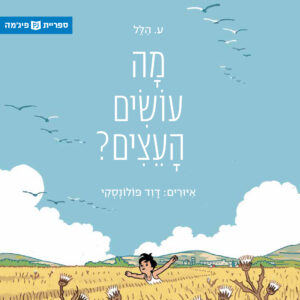 What Do the Trees Do?
What Do the Trees Do? 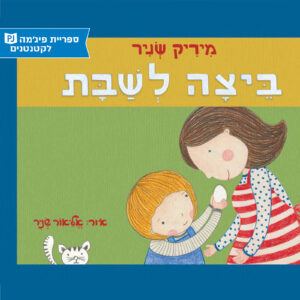 An Egg for Shabbat
An Egg for Shabbat 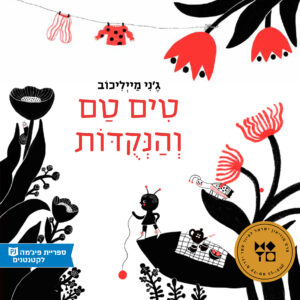 Tim Tam and the Spots
Tim Tam and the Spots 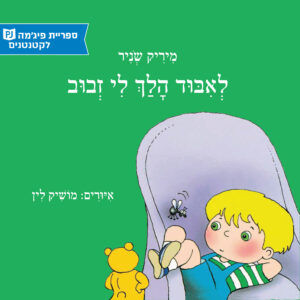 The Fly That Got Lost
The Fly That Got Lost 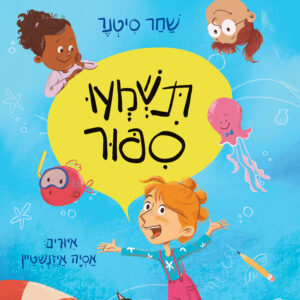 Let Me Tell You a Story
Let Me Tell You a Story 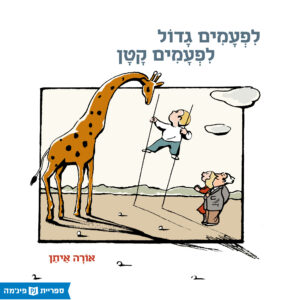 BIG OR SMALL
BIG OR SMALL 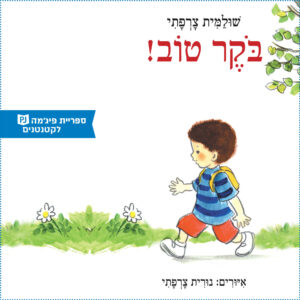 Good Morning!
Good Morning! 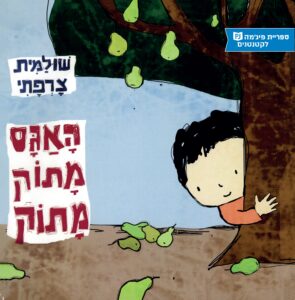 21,600The Pear is Extra Sweet
21,600The Pear is Extra Sweet 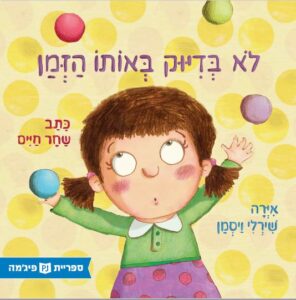 Not at the Exact Same Time
Not at the Exact Same Time 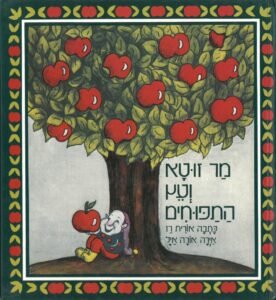 Mr. Zuta and the Apple Tree
Mr. Zuta and the Apple Tree 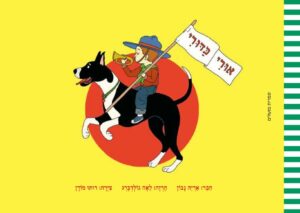 Uri Kadori
Uri Kadori 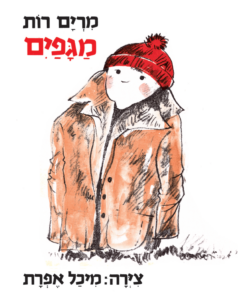 Boots
Boots 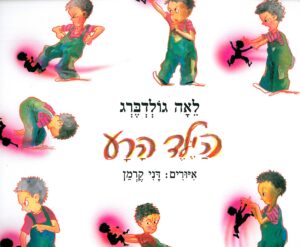 The Naughty Boy
The Naughty Boy 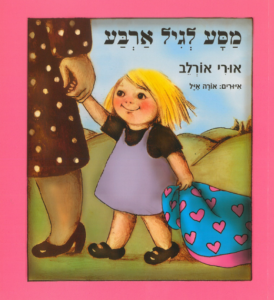 Journey to Age Four
Journey to Age Four 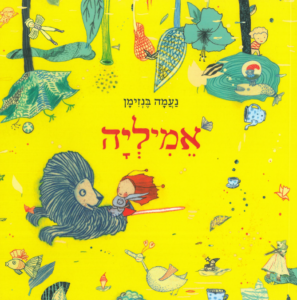 EMILIA
EMILIA 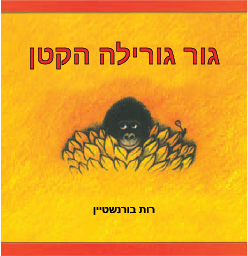 Little Gorilla
Little Gorilla 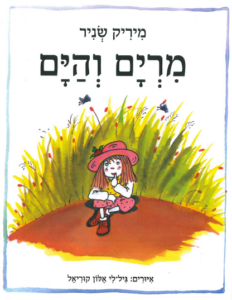 Miriam and the Sea
Miriam and the Sea 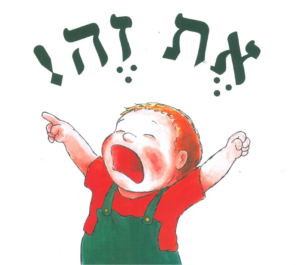 That One!
That One! 














